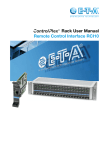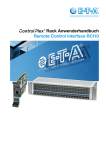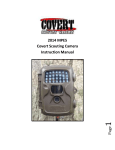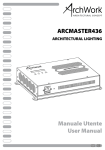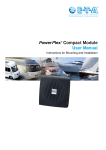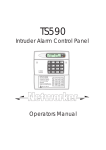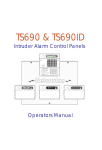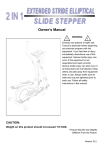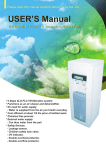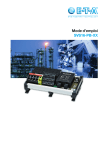Download Rack Installation and User Manual
Transcript
Rack Installation and User Manual Date of issue: Date of publication: August 2015 This document replaces the following documents: „ControlPlex® Rack Montageanleitung _140129_i-„ / Ausgabe vom 29. Jan. 2014 Editor: E-T-A Elektrotechnische Apparate GmbH Industriestraße 2-8 . 90518 ALTDORF GERMANY Phone +49 9187 10-0 . Fax +49 9187 10-397 E-Mail: [email protected] . www.e-t-a.de Copyright © 2015 E-T-A GmbH The contents of this document is the property of E-T-A GmbH. No part of this publication must in any we be reproduced or distributed without prior written consent of E-T-A GmbH. Any person acting illegally with regard to this publication can be prosecuted. Limitation of liability Although all provisions were taken when creating this document, the editor does not accept any reponsibility for errors or omissions or for damages caused by using the information contained in this document. The information contained in this document may be revised at any time without advance notice. Brands All references to software and hardware in this document are generally protected by brands or patents. © E-T-A GmbH 2015. All rights reserved 2 About this manual This manual describes the electrical start-up of the ControlPlex® Rack system in connection with compatible ControlPlex® Rack components. The ControlPlex® Rack allows artless and reliable protection and monitoring of minus-supplied systems. Typical applications include telecommunications as well as IT centres, e.g. the protection and electrical monitoring of server or router cabinets. Besides this document, more information about the E-T-A ControlPlex® Rack can be found in the following documents. ControlPlex® Rack Data sheet Here you will find more technical data and figures as well as approval information on the various components of the ControlPlex® Rack system ControlPlex® Rack User manual RCI10 Here you will find an instruction for configuration and for integrating the module Remote Control Interface RCI10 into your network. In addition this document holds a user description of the web browser and the SSH surface as well as the SNMP MIB for integration into a management system. The latest documents can be found on our website under www.e-t-a.de/controlplex_rack All documents contain important instructions for connection and safe operation of the ControlPlex® Rack system. Safety instructions have to be observed. All users have to be informed about all safety instructions. The documents have to be accessible for the user. 3 General note Qualified personnel he system must only be installed, connected and configured in connection with this document. Installation T and operation of the device/system must only be carried out by qualified personnel. With regard to the safety instructions of this documentation, qualified persons are persons authorised to operate devices, systems and circuits according to the standards and rules of safety engineering. Safety instructions Please follow the installation and configuration instructions given in this document carefully. Failure to comply may lead to serious damages of the product or the system. E-T-A does not accept any liability for problems caused by improper installation or handling by the customer or a third person. Symbols You will find the following symbols in the entire manual. Their meaning is as follows: Danger! You are in a situation which might cause injury. Before working with one of the devices you have to be aware of the risks of electrical circuitries and you ought to be familiar with standard procedures of accident prevention. Warning There is a risk in this situation to do something which might cause damage of the devices or data loss. Note Here you receive information which might be particularly useful for the application. Caution: Electrostatically sensitive devices (ESD). Devices must exclusively be opened by the manufacturer. 4 Contents About this manual............................................................................................................................................3 General note.....................................................................................................................................................4 Contents............................................................................................................................................................5 1Introduction..............................................................................................................................................6 2 Minimal requirements of installation.....................................................................................................7 3General: ControlPlex® Rack Power-D-Box®..........................................................................................8 3.1 Use of the Power-D-Box®................................................................................................................8 3.2 Technical data of the Power-D-Box®...............................................................................................9 3.3 Scope of delivery of the Power-D-Box®........................................................................................10 3.4 Pictures of Power-D-Box® versions (front view)............................................................................10 3.5 Drawings and dimensions of Power-D-Box® versions...................................................................11 3.6 Schematic diagrams of Power-D-Box® versions...........................................................................13 3.7 Pin assignment of Power-D-Box® versions...................................................................................14 3.8 Installation and start-up of the Power-D-Box®..............................................................................16 3.8.1 Recommended installation site for Power-D-Box®..........................................................16 3.8.2 Basic notes on cabling for Power-D-Box®.......................................................................16 3.8.3 Mounting and start-up of Power-D-Box®.........................................................................17 4General: ControlPlex® Rack, electronic circuit protector ESX300-S................................................19 4.1 Application ESX300-S.....................................................................................................................19 4.2 Technical data of the Power-D-Box®............................................................................................19 4.2.1 Current rating, voltage drop and load capacity of ESX300-S...........................................20 4.2.2 LED status indication.........................................................................................................20 4.3 Delivery scope ESX300-S...............................................................................................................20 4.4 Picture of ESX300-S.......................................................................................................................21 4.5 Installation and start-up ESX300-S.................................................................................................21 4.6 Removal of the electronic circuit protector ESX300-S...................................................................23 4.7 Trouble-shooting concerning electronic circuit protector ESX300-S..............................................24 5General: ControlPlex® Rack, control interface RCI10........................................................................25 5.1 Application of RCI10.......................................................................................................................25 5.2 Technical data of RCI10..................................................................................................................25 5.2.1 Momentary switch function and LED status indication.....................................................26 5.2.2 Function IP-reset by pressing the reset button with LED display......................................27 5.3 Delivery scope RCI10......................................................................................................................27 5.4 Picture of RCI10..............................................................................................................................27 5.5 Installation and start-up RCI10.......................................................................................................28 5.5.1Picture of slot for Remote Control Interface RCI10........................................................................29 5.5.2Picture of an example for network connection...............................................................................29 5.6 Configuration and start-up RCI10...................................................................................................29 Notes...............................................................................................................................................................30 5 1Introduction You chose ControlPlex® Rack, a comprehensive, future-oriented protection system which combines safety, user convenience and service friendliness. It is a power distribution and management system which provides electronic and, in the event of a short circuit, current-limiting protection of various loads. By means of an internal bus system and an additional, hot-pluggable control interface module (optional), each load can remotely be controlled and monitored. In addition it allows recording of measuring data of every single load. Besides providing overcurrent and short circuit protection, it increases system availability by a multiple, because it disconnects faulty loads quickly, selectively and without voltage dips. In connection with the control interface module type RCI10 the ControlPlex® Rack system can be connected to a centralised management system (control computer). For this purpose an Ethernet interface is made available with SNMP v1, v2c or v3 protocol. The required private MIB for embedding is part of the delivery scope. An additional possibility for a centralised or also local monitoring/control is provided by the integral web server, which can be used without additional software on the control computer by means of the web browser. Thanks to its system properties the ControlPlex® Rack is the perfect solution for smart protection, control and energy measurement for DC-supplied minus switching system cabinets. Typical applications include: • System cabinets of any kind in telecommunications with DC -48 V or DC -60 V rated supply • Server cabinets in IT centres with equipment for DC -48 V or DC -60 V rated supply • System cabinets for mobile radio and television for DC -40 V to DC -72 V • Protection and control of illuminated advertising with a power supply of DC -48 V Further descriptions of the ControlPlex® Rack system with information on the configuration and network connection by means of the module control interface RCI10 are available in the user manual ControlPlex® Rack. This document contains the mounting and connection procedures for the hardware of the ControlPlex® Rack system as well as an instruction for the first operation. You will learn more about •how to mount and connect the different ControlPlex® Rack Power-D-Box® versions • how to start up or exchange the electronic circuit protectors type ESX300-S • how to identify and remedy failures of the electronic circuit protectors ESX300-S • how to install and connect the optional control interface RCI10 • how to identify and remedy failures of the control interface RCI10 by means of LED indication 6 2 Minimal requirements of installation Please check the delivered components upon receipt with regard to completeness. You require the following hardware components for installation and start-up of the ControlPlex® Rack system: • One or more Power-D-Box modules type: PDB-N-CPxxx-xx-x or special versions such as PDB-N-CPxxx-xx-A-Sxxx •Electronic circuit protectors type ESX300-S-x00-xx A (version e.g.: with signalling or with BUS interface, various current ratings: 2 A…24 A) •Optional: control interface with Ethernet interface type RCI10-000-x. The circuit protector type ESX300-S300-xxA is mandatory for use with control interface. In addition you require different cables for connection of the Power-D-Box®, of the supply line, the loads and the ground. Many manufacturers offer standard cables for this purpose. 2.1 Important information and safety instructions The following table lists various information and safety instructions for start-up and use of the device. Danger: Installation and operation of the device This device has to be installed and operated in compliance with the given instructions. Failure to comply can lead to injury, damage of loads or of the ControlPlex® Rack system. Danger: Turn off the supply voltage Before beginning with installation, the system has to be disconnected from the mains. A cable connection must only be established if the supply voltage is OFF. Danger: Possible ignition hazard The device must NOT be used in inflammable surroundings. Danger: High voltage The cover must NEVER be opened. Access to the inner components is not allowed unless indicated otherwise in this manual. Caution: Work with ESD protection Electronic modules must only be touched and installed with ESD protection so as to ensure protection against electrostatic voltage. Failure to comply can cause damages on the ControlPlex® Rack system or the corresponding components. Caution: Grounding The device must be grounded before switching on. Table 1: Important information 2.12 EMC installation guidelines The ControlPlex® Rack hardware and accessories comply with the EMC directives. Thus electromagnetic interferences between the devices are avoided which would otherwise affect the system performance. A professional installation is mandatory. In order to ensure the best EMC conditions, the widest possible distance between the different electrical devices should be applied. 2.3 Technical Accuracy All technical data in this manual were correct in all conscience at the time of printing. E-T-A cannot be held liable for any (inadvertent) errors. Due to continuous product improvements at E-T-A there could be discrepancies between the actual product and the manual. Product changes or amendments of the technical specifications will be carried our without prior notification. The latest versions of the ControlPlex® Rack documents are available on our website (www.e-t-a.de). 7 3General: ControlPlex® Rack Power-D-Box® By using the Power-D-Box® type PDB-N-CPxxx-xx-x you can benefit from the advantages of the ControlPlex® Rack system to full extent, no matter whether the control interface RCI10 is used from the start or only later. 3.1 Use of the Power-D-Box® The ControlPlex® Rack Power-D-Box® has been designed for the quick and easy installation into 19" or ETSI racks which is ensured by a rotating mounting flange. Depending on the required termination technology (front or rear) the corresponding Power-D-Box® is available as a product. The service friendliness has to be mentioned as a special advantage. The system can be extended with power on and additional circuit protectors can be plugged into the load terminals. The control interface can also be fitted later with power on without having to disconnect the loads. 8 3.2 Technical data of the Power-D-Box® The entire 19" rack features the protection degree IP20. Table 2 summarizes the vital information. Electrical data PDB-NCP09A-RR-S PDB-NCP09A-RF-S PDB-NCP09A-FF-S PDB-NCP19A-RR-S PDB-NCP18R-RR-S Operating voltage DC -48 V or DC -60 V DC -48 V or DC -60 V DC -48 V or DC -60 V DC -48 V or DC -60 V DC -48 V or DC -60 V Max. supply current: 150 A 150 A 100 A 200 A 2 x 150 A Number of circuit protectors 9 9 9 19 18 Redundant system no no no no yes Protected pole Negative pole protected electronically, without physical isolation Suitable for circuit protector ESX300-S (2 A, 5 A, 8 A, 12 A, 16 A, 20 A, 24 A, with/without aux. contact), with / without BUS) Ambient temperature Mechanical data -20 … +60 °C PDB-NCP09A-RR-S PDB-NCP09A-RF-S Dimensions PDB-NCP09A-FF-S PDB-NCP19A-RR-S PDB-NCP18R-RR-S see drawings and dimensions Mounting 4 mounting screws M6 x 16 mm (not supplied with product) tightening torque 5.3...5.7 Nm Supply PDB-NCP09A-RR-S PDB-NCP09A-RF-S PDB-NCP09A-FF-S PDB-NCP19A-RR-S PDB-NCP18R-RR-S Terminals on the rear on the rear on the front on the rear on the rear Screw terminals 16 – 50 mm² AWG 5 – AWG 1 16 – 50 mm² AWG 5 – AWG 1 4 – 25 mm² AWG 11 – AWG 3 16 – 50 mm² AWG 5 – AWG 1 16 – 50 mm² AWG 5 – AWG 1 Tightening torque 6…8 Nm 6…8 Nm 4...4.5 Nm 6…8 Nm 6…8 Nm Loads PDB-NCP09A-RR-S PDB-NCP09A-RF-S PDB-NCP09A-FF-S PDB-NCP19A-RR-S PDB-NCP18R-RR-S Max. load current per load terminal 30 A with 9 ways 30 A with 9 ways 30 A with 9 ways 30 A with 19 ways 30 A with 2 x 9 ways Terminals on the rear on the front on the front on the rear on the rear Screw terminals 0.5 – 6 mm² AWG 20 – AWG 10 – – 0.5 – 6 mm² AWG 20 – AWG 10 0.5 – 6 mm² AWG 20 – AWG 10 SUB-D connector – 2.5 – 10 mm² AWG 13 – AWG 7 2.5 – 10 mm² AWG 13 – AWG 7 – – Tightening torque 0.5…0.8 Nm – – 0.5…0.8 Nm 0.5…0.8 Nm Signalling PDB-NCP09A-RR-S PDB-NCP09A-RF-S PDB-NCP09A-FF-S PDB-NCP19A-RR-S PDB-NCP18R-RR-S Terminals on the rear on the front on the front on the rear on the rear Screw terminals 0.25–1.5 mm² AWG 23 – AWG 16 – – 0.25–1.5 mm² AWG 23 – AWG 16 0.25–1.5 mm² AWG 23 – AWG 16 SUB-D connector – 2.5 – 10 mm² AWG 13 – AWG 7 2.5 – 10 mm² AWG 13 – AWG 7 – – Tightening torque 0.22…0.25 Nm – – 0.22…0.25 Nm 0.22…0.25 Nm Grounding PDB-NCP09A-RR-S PDB-NCP09A-RF-S PDB-NCP09A-FF-S PDB-NCP19A-RR-S PDB-NCP18R-RR-S Ground connector M6 ground stud, always on the rear, tightening torque 6 Nm Table 2: A selection of technical data / *) further information can be found in the data sheet. 9 3.3 Scope of delivery of the Power-D-Box® The following parts are part of the delivery scope of the Power-D-Box®: • 19" rack with 19" / ETSI interchangeable flange (mounted 19") • blanking pieces for slots of circuit protectors and control interface (mounted) • mating plugs in the event of rear screw terminals (plugged on). Versions: PDB-N-CPxxx-xR-x • mating plugs of signalling terminals (screwed on). Versions: PDB-N-CPxxx-xR-x The following accessories can be ordered separately: • rear cable grip rail (part no. X 223 260 01) • connector set, high current SUB-D for load terminal on the front (part no. X 223 189 01) •marking frame with labels, 0.5U, for customised marking of circuit protectors (part no. X 223 575 01) •marking frame with labels, 1U with cable gland on the front, for customised marking of circuit protectors (part no. X 223 576 01) • circuit protector type ESX300-S-xxx-xxA • control interface type RCI10-xxx-x For more information on accessories please see the data sheet of ControlPlex® Rack. 3.4 Pictures of Power-D-Box® versions (front view) fig. 1: Front view PDB-N-CP18R-RR-x, PDB-N-CP19A-RR-x fig. 2: Front view PDB-N-CP09A-RR-x fig. 3: Front view PDB-N-CP09A-FF-x, terminals on the front with high current SUB-D connectors 10 3.5 Drawings and dimensions of Power-D-Box® versions 515 (ETS) 75 (ETS) 88.9 (2HE) 76.2 (19“) 465 (19“) fig. 4: Front view PDB-N-CP09A-FF-x, 1 x 9 slots, terminals on the front with high current SUB-D connectors fig. 5: Rear view PDB-N-CP09A-FF-x, 1 x 9 slots (with rear cable grip rail) 88.9 482.6 fig. 6: Front view PDB-N-CP19A-RR-x, 1 x 19 slots fig. 7: Rear view DB-N-CP19A-RR-x, without cable grip 11 515 (ETS) 75 (ETS) 482.6 (19“) 531.4 (ETS) fig. 8: Front view PDB-N-CP18R-RR-x, 2 x 9 slots fig. 9: Rear view PDB-N-CP18R-RR-x, 2 x 9 slots cable grip set (optional) cable guide supply 14 450 fig. 10: Top view PDB-N-CP18R-RR-x, 2 x 9 slots (with rear cable grip rail) 12 201.5 160 171.5 271.5 cable guide loads and Si 88.9 (2HE) 76.2 (19“) 465 (19“) 3.6 Schematic diagrams of Power-D-Box® versions non-redundant design supply A A1 A+ 2 11 OK FAULT OK FAULT OK FAULT OK FAULT OK FAULT OK FAULT OK FAULT LINE- SI LINE- SI LINE- SI LINE- SI LINE- SI LINE- SI LINE- SI LINE- SI LINE- SI LOAD- SI SI LOAD- SI LOAD- SI LOAD- LOAD- A19- A18- SI SI LOAD- SI LOAD- SI 2 12 14 -X2 2 12 14 2 12 14 2 12 14 2 12 14 2 12 14 2 12 14 2 12 14 2 12 14 2 12 14 2 12 14 2 12 14 2 12 14 2 12 14 2 12 14 2 12 14 2 12 14 2 12 14 SI SI SI SI SI SI SI SI SI SI SI SI SI SI SI SI SI SI SI SI SI SI SI SI SI SI SI SI SI SI SI SI ESX300-S E-T-A SI ESX300-S E-T-A SI ESX300-S E-T-A SI ESX300-S E-T-A SI ESX300-S E-T-A SI ESX300-S E-T-A SI ESX300-S E-T-A LOAD- LOAD- LOAD- SI ESX300-S E-T-A LOAD- LOAD- LOAD- SI ESX300-S E-T-A LOAD- LOAD- ESX300-S E-T-A LOAD- SI ESX300-S E-T-A LOAD- LOAD- ESX300-S E-T-A LOAD- SI ESX300-S E-T-A LOAD- LOAD- ESX300-S E-T-A LOAD- SI ESX300-S E-T-A LOAD- LOAD- A14- A9- SI ESX300-S E-T-A LOAD- LOAD- ESX300-S E-T-A LOAD- SI ESX300-S E-T-A LOAD- LOAD- ESX300-S E-T-A LOAD- SI OK FAULT LINE- SI LOAD- LOAD- 11 LOAD- SI A17- OK FAULT LINE- SI A16- OK FAULT LINE- SI A15- OK FAULT LINE- SI A13- OK FAULT LINE- SI A12- OK FAULT LINE- SI A11- OK FAULT LINE- SI A10- OK FAULT SI A8- OK FAULT LINE- A7- OK FAULT LOAD- 1 GND+ 1 LINE- 11 GND+ 1 LINE- 11 GND+ 1 LINE- 11 GND+ 1 LINE- 11 GND+ 1 LINE- 11 GND+ 1 LINE- 11 GND+ 1 LINE- 11 GND+ 1 LINE- LINE- 11 GND+ 1 LINE- 11 GND+ 1 LINE- 11 GND+ 1 LINE- LINE- LINE- 11 GND+ 1 GND+ 11 GND+ 1 GND+ 11 LINE- GND+ LINE- GND+ LINE- 1 LOAD- SI 11 LOAD- LOAD- 1 A6- SI SI A2LOAD- OK FAULT LINE- A1- SI 11 A5- OK FAULT LINE- 1 A3- LINE- 11 A4- 1 GND+ 11 GND+ 1 LINE- -X1 2 12 14 2 1 A9- A9+ -X3 A18- A18+ 38 37 -X3 A17- A17+ 36 35 -X3 A16- A16+ 34 33 32 -X3 A15- A15+ 31 30 -X3 A14- A14+ 29 28 -X3 A13- A13+ 27 -X3 A12- A12+ 26 25 -X3 A11- A11+ 24 23 22 -X3 A10- A10+ 21 20 19 -X3 18 -X3 A8- A8+ A7- A7+ 17 16 15 -X3 14 -X3 A6- A6+ 13 -X3 A5- A5+ 12 11 -X3 A4- A4+ 10 9 -X3 A3- A3+ 8 7 -X3 A2- A2+ A1- A1+ 6 5 4 3 -X3 2 1 signalling A (optional) -X3 A19- A19+ load outputs A fig. 11: Schematic diagram PDB-N-CP19A-RR-x, 1 x 19 slots with signalling redundant design B- SI LOAD- SI LOAD- SI LOAD- SI LOAD- SI LOAD- SI -X5 A1- A1+ 1 2 12 14 SI SI SI SI 2 12 14 ESX300-S E-T-A 2 12 14 2 12 14 ESX300-S E-T-A 2 12 14 ESX300-S E-T-A 2 12 14 SI LOAD- SI GND+ LINE- GND+ LINELINE- OK FAULT LINE- SI ESX300-S E-T-A LOAD- SI 2 12 14 ESX300-S E-T-A 2 12 14 2 A2- A2+ A3- A3+ A4- A4+ A5- A5+ A6- A6+ A7- A7+ A8- A8+ A9- A9+ B1- B1+ load outputs A B2- B2+ B3- B3+ B4- B4+ B5- B5+ B6- B6+ B7- B7+ B8- B8+ 18 17 16 15 14 13 12 11 10 9 8 7 6 5 4 3 2 -X6 1 18 17 16 15 14 13 12 11 10 9 8 7 6 5 4 signalling B (optional) 3 2 1 signalling A (optional) SI LOAD- 2 12 14 SI LOAD- 2 SI LOAD- 2 12 14 SI SI LOAD- 2 12 14 SI LOAD- SI SI LOAD- SI SI LOAD- SI SI LOAD- SI LOAD- SI LOAD- SI LOAD- SI LOAD- SI LOAD- 1 -X2 SI ESX300-S E-T-A SI ESX300-S E-T-A SI ESX300-S E-T-A SI ESX300-S E-T-A SI ESX300-S E-T-A OK FAULT SI LINE- ESX300-S E-T-A 2 12 14 GND+ SI ESX300-S E-T-A 2 12 14 LINE- LINE- ESX300-S E-T-A 2 12 14 GND+ SI ESX300-S E-T-A 2 12 14 LINE- LINE- ESX300-S E-T-A 2 12 14 GND+ OK FAULT SI ESX300-S E-T-A 2 12 14 LINE- GND+ LINE- OK FAULT LINE- 11 SI SI GND+ LINE- GND+ LOAD- OK FAULT SI 1 B9- SI OK FAULT LINE- 11 LOAD- LOAD- OK FAULT ESX300-S E-T-A 1 SI SI SI ESX300-S E-T-A 2 12 14 -X3 GND+ LINE- GND+ LINELOAD- LINE- 11 SI SI OK FAULT 1 B8- LOAD- SI 11 LOAD- SI GND+ LINE- GND+ LOAD- LINE- 1 SI SI SI 11 SI LOAD- OK FAULT LINE- 1 LOAD- SI OK FAULT 11 B7- LOAD- SI 1 SI SI LINE- 11 SI LOAD- OK FAULT 1 LOAD- SI SI 11 B6- LOAD- LINE- 1 SI SI OK FAULT 11 SI LOAD- SI 1 LOAD- SI LINE- 11 B5- LOAD- OK FAULT 1 B4- SI 11 B2- LINE- 1 2 B1- SI 11 A9- LINE- 1 A8- SI 11 A6- OK FAULT LINE- A5- OK FAULT SI A4- OK FAULT LINE- A3- OK FAULT SI A2- OK FAULT LINEA1- 1 LINE- 11 GND+ 1 A7- 11 LINE- 1 GND+ 11 LINE- 1 GND+ LINE- LINE- 11 LINE- 1 GND+ 11 LINE- 1 B+ 1 -X4 GND+ 2 B3- A+ 1 GND+ A-X1 supply B LINE- supply A B9- B9+ load outputs B fig. 12: Schematic diagram PDB-N-CP18R-RR-x, 2 x 9 slots with signalling 13 3.7 Pin assignment of Power-D-Box® versions Pin assignment PDB-N-CP09A-RR-x, PDB-N-CP18R-RR-x • Rear-side supply terminals DC 48 V – DC 60 V / max. 2 x 150 A • Cable cross section max. 50 mm² plus 48 V DC B+ minus 48 V DC B- loads B-/B+ plus 48 V DC A+ minus 48 V DC A- loads A-/A+ group signalling B group signalling A fig.13 version PDB-N-CP18R-RR-x, pin assignment (cable grip removed) Pin assignment PDB-N-CP09A-FF-x • Front-side supply terminals DC 48 V – DC 60 V / max. 100 A • Cable cross section max. 25 mm² • Front-side supply terminals A1... A9 DC 48 V – DC 60 V / max. 30 A • Cable cross section max. 10 mm² • Signal terminals Si max. DC 72 V / 1 A ampacity, max. 60 W / 62.5 VA switching capacity 14 minus 48 V DC ANo not connected C not connected minus 48 V DC protected pole plus 48 V DC A+ plus 48 V DC group signaling fig. 14 version PDB-N-CP09A-FF-x, pin assignment Pin assignment PDB-N-CP09A-RF-x • line entry see PDB-N-CP09A-RR-x (group A) • load terminals see PDB-N-CP09A-FF-x (group A) Pin assignment PDB-N-CP19A-RR-x •Rear-side supply terminals DC 48 V - DC 60 V / max. 200 A with supply via two supply terminals (internally bridged). Max. 150 A per supply terminal at 50 mm² cable cross section. • cable cross section max. 50 mm² per supply line • cable cross section max. 4 mm² with wire end ferrule per load terminal minus 48 V DC Amax. 150 A per terminal plus 48 V DC A+ max. 150 A per terminal cable grip minus 48 V DC Amax. 150 A per terminal plus 48 V DC A+ max. 150 A per terminal load A19-/19+...A1-/A1+ group signaling fig. 15 version PDB-N-CP19A-RR-x, pin assignment (cable grip installed) 15 3.8 Installation and start-up of the Power-D-Box® The ControlPlex® Rack system has been designed for stationary installation in an indoor system cabinet. For installation in an outdoor cabinet we recommend a fully conditioned cabinet with heating and cooling. In the event of high humidity the surrounding has to be additionally dried. 3.8.1 Recommended installation site for Power-D-Box® Usually the Power-D-Box® is installed in the top or bottom area of the system rack. We recommend installation in close proximity to the connected loads so as to reduce wiring and cable management. Important: • Leave sufficient space for heat dissipation, min. 0.5U above Power-D-Box® should be free for ventilation. • Please take care to install the Power-D-Box® in enclosed and dry rooms. • Please observe the required degree of protection. or below the GENERAL REQUIREMENTS OF INSTALLATION SITE Various aspects have to be considered when choosing the installation site. Ventilation Please ensure sufficient ventilation by leaving enough space at all sides of the device and ensure that the vent holes are not blocked. Leave enough space between the devices. Cable management Ensure installation at a site where the cables can be laid and connected properly. Ensure ease of access for service and system extensions of all termination versions even after installation. Electrical noise pulses The installation site should provide sufficient distance to any devices that might emit noise pulses. Table 3: Power-D-Box® requirements of installation site 3.8.2 Basic notes on cabling for Power-D-Box® The selection of the correct cable types regarding temperature resistance and ampacity is important for the reliable power distribution, control and monitoring by means of a ControlPlex® Rack system. Please ensure to use cables of superior quality with the suitable cross sections so as to avoid voltage drops. Laying of cables must be carried out carefully. Table 4 gives general hints regarding wiring of a Power-D-Box®, including the connected loads. Item Note 1 Cables must be protected against damages and heat. Avoid the proximity to moveable or hot parts and to machines. 2 Ensure a suitable strain relief. 3 Check cables with regard to intact insulation, above all after cable laying. Table 4: Power-D-Box® wiring hints 16 3.8.3 Installation and start-up of the Power-D-Box® Important notes Danger: Turn off the supply voltage Before beginning with installation, the system has to be disconnected from the mains. A cable connection must only be established if the supply voltage is OFF. Caution: Work with ESD protection To protect electronic components against electrostatic voltage, any work must only be carried out with corresponding ESD protection means. Failure to comply can cause damages on the ControlPlex® Rack system or the corresponding components. Caution: Mounting position The Power-D-Box® must only be installed horizontally in the cabinet, vertical installation may cause overheating. Caution: Supply voltage The voltage of the power supply must be between DC 38 V and DC 72 V to ensure a smooth operation. In the event of a voltage in excess of DC 75 V the Power-D-Box® may be damaged. Table 5: Power-D-Box® Important hints for start-up Start-up of the Power-D-Box® comprises the following steps: Step Action 1 Prepare all necessary devices and tools such as: • different screw drivers and M6 box wrench (part of the delivery scope) • connecting cables for power supply and ground (part of the delivery scope) • connecting cables for load terminals (not part of the delivery scope) • 4 mounting screws M6 x 16mm with plastic sleeve • 2 x M6 cable lug, not part of the delivery scope (ground connection Power-D-Box®) • Load terminal mating plug (can be ordered as accessory for version with front connection, otherwise it is part of the Power-D-Box® delivery scope) 2 If installation shall be in an ETSI rack: Re-work of the Power-D-Box® mounting brackets to ETSI dimensions: remove, turn bracket by 180°, re-fit with the 2 mounting screws. 3 Important: Please ensure that the system is dead-voltage. 4 Lay all necessary cables for grounding, supply and load terminals of the Power-D-Box® 5 Connect the load terminal cables with the corresponding load connectors and mark them with the corresponding way no. of the Power-D-Box® Important: Do not yet connect the load connectors to the Power-D-Box®. Depending on the version, see chapter 4.7 pin assignment Depending on the version, tightening torque of supply terminals, see table 2, "Technical data/supply" 17 6 Mounting of Power-D-Box® in the system cabinet: Install the Power-D-Box® horizontally in the system cabinet and fix it with the 4 supplied mounting screws. The tightening torque of the mounting screws is 5.3 - 5.7 Nm. 7 Connection of the Power-D-Box® grounding cable: The ground connection is on the rear side of the Power-D-Box® (see fig. 15) and is marked with a grounding symbol. In the event of two separate power supplies (redundant system) both ground connections have to be connected with one grounding cable each. The grounding cable can be fixed with an M6 cable lug and the fitted grounding nut with a tightening torque of 6 Nm. 8 Connection of the Power-D-Box® supply lines: Depending on the version, see chapter 4.7 pin assignment Depending on the version, tightening torque of supply terminals, see table 2, “Technical data/supply” Important: Do not yet connect any load lines. 9 Switch on the power supply. Check correct polarity with a voltmeter (plus, minus) and the correct voltage value of the power supply terminals. In the event of a failure please remedy before proceeding with step 10. 10 Optional: Connection of the Power-D-Box® signalling lines: Depending on the version, see chapter 3.7 pin assignment Depending on the version, tightening torque of supply terminals, see table 2, “Technical data/supply” 11 Go to chapter 4 “ControlPlex® Rack, electornic circuit protector ESX300-S” End Table 6: Power-D-Box® steps for start-up 18 4General: ControlPlex® Rack, electronic circuit protector ESX300-S The electronic circuit protector ESX300-S with active current limitation for use in minus-switching equipment has particularly been designed for the use in the Power-D-Box® of type PDB-N-CPxxx-xx-x. It can be installed and de-installed with the system live without having to disconnect the application from the mains. Thus you can reduce the installation and service periods to a minimum. 4.1 Application ESX300-S The electronic circuit protector ESX300-S is suitable for minus supplied systems with voltage ratings from DC -48 V and DC -60 V. It is capable of disconnecting all faulty loads selectively in the event of overcurrent and short circuit, i.e. without voltage dip or failure of neighbouring loads. In the event of overcurrent or short circuit the active current limitation of the ESX300-S prevents an overload-dependent voltage regulation of the (switched mode) power supply. In the event of a failure the latter prevents a voltage dip of the switch-mode power supply and thus repercussions on the neighbouring loads. The ESX300-S is available both with BUS interface and with potential-free signalling. The version with BUS interface in connection with the control interface RCI10 (see chapter 5) allows failure indication as well as an automatic remote control of the ESX300-S via a controlling computer. 4.2 Technical data of ESX300-S Technical data ESX300-S Current ratings 2 A, 5 A, 8 A, 12 A, 16 A, 20 A, 24 A Capacitive load max. 7,000 uF (depending on the current rating) Trip electronically (1-pole), no physical isolation Threshold for active current limitation typically 1.2 x rated current ESX300-S Reliability in the event of faulty electronics integral fail-safe element (blade fuse) Protected pole minus pole protected Operating voltage DC -37V to DC -72V Signalling (optional) potential-free auxiliary contacts BUS system (optional) EL-BUS for communication with sub-assembly RCI10 Status indication LEDs red and green Low voltage indication < DC -37 V Overvoltage indication = / > DC minus 72 V Trip times typically < 10 ms at short circuit (current limitation active) typically < 30 sec at overcurrent (I > IN < current limitation threshold) Approval logos CE to EN 61000-6-3 / EN 61000-6-2 Mechanical data ESX300-S Ambient temperature - 20° C...+60° C* Cooling convection cooling Mounting position vertical mounting position Version rack module with front plate, no separate enclosure, for installation in Power-D-Boxes® Table 7: ESX300-S, technical data *) major technical data, for further information please see data sheet of ControlPlex® Rack 19 4.2 Current ratings, voltage drop and load capacity ESX300-S trip time max. load current at 100 % ON duty Current rating range IN typical voltage drop UON at IN active current limitation typically 2A 130 mV 1.20 x IN 0.2 – 3 s 4A 2A 1500 5A 130 mV 1.20 x IN 0.2 – 3 s 10 A 5A 2000 8A 200 mV 1.20 x IN 0.2 – 3 s 10 A 8A 3000 12 A 150 mV 1.20 x IN 0.2 – 3 s 20 A 12 A 4000 16 A 200 mV 1.20 x IN 0.2 – 3 s 20 A 16 A 5000 20 A 160 mV 1.20 x IN 0.2 – 3 s 30 A 20 A 6000 24 A 200 mV 1.20 x IN 0.2 – 3 s 30 A 24 A 7000 typically at 1.2 x IN Fail-safe element TAMB = 40 °C Max. capacitive load (µF) Note:The total current of neighbouring devices must not exceed 44 A. The derating factor at an ambient temperature of > 40 °C is 0.8 times rated current. Table 8: ESX300-S, electrical data 4.2.2 LED Status Indication Load output LED green LED red auxiliary contact N/C (optional) No error -> OFF locked flashing slowly OFF open Normal operation connected ON OFF open Error undervoltage with device in OFF condition (15 V < U < 37 V) locked OFF ON closed Error undervoltage with device in OFF condition (U > 72 V) locked OFF ON closed Overcurrent error detected (I > IN < 1.2 x IN); overcurrent failure has to be detected for approx. 30 sec before disconnection is effected connected ON flashing fast open Error - overcurrent or short circuit disconnection locked OFF ON closed Error undervoltage (U > 15 V < 37 V) connected ON ON closed error overvoltage (72 V < U < 75 V) operating state connected ON ON closed Error, no voltage or internal error locked OFF OFF closed Error high temperature locked OFF flashing slowly closed Remote disconnection (ordering option control interface) locked flashing fast OFF ------ Table 9: ESX300-S operating conditions - LED indication 4.3 Delivery scope ESX300-S The following parts are part of the delivery scope of the ESX300-S: • Electronic circuit protector, type: ESX300-S-xxx-xxA with front plate • Removeable label in the front plate 20 4.4 Picture of ESX300-S status LED engagement nose ON/OFF groove for label rated current of circuit protector Fig. 16: ESX300-S circuit protector 4.5 Installation and start-up ESX300-S Important notes Note: Power-D-Box® installed Before starting the installation, the Power-D-Box® has to be properly installed first and supply voltage should be applied. All steps in chapter 3 were carried out properly. Caution: Work with ESD protection To protect electronic components against electrostatic voltage, any work must only be carried out with corresponding ESD protection means. Failure to comply can cause damages on the ControlPlex® Rack system or the corresponding components. Caution: Mounting position The ESX300-S sub-assembly has to be pushed in vertically into the Power-D-Box. Caution: load terminal Load terminal must be open (not connected) when installing the ESX300-S. Caution: Supply voltage The voltage of the power supply must be between DC 38 V and DC 72 V to ensure a smooth operation. In the event of a voltage in excess of DC 75 V the electronic circuit protector may be damaged. Table 10: ESX300-S, important hints for start-up 21 Start-up of the ESX300-S comprises the following steps: Step Action 1 Prepare all necessary devices and tools such as: • Electronic circuit protectors ESX300-S (check the ESX300-S with regard to the required current ratings, see chapter 4.5 fig. 16 “rated current value” 2 Danger: Please ensure that all steps in chapter 3 for starting up the Power-D-Box® are carried out correctly. 3 Caution: The total current of neighbouring devices must not exceed 44 A. The derating factor is 0.8 times rated current of the ESX300-S with ambient temperatures > 40 °C. 4 Installation of the circuit protectors ESX300-S into the Power-D-Box®: Push the ESX300-S with the correct current rating carefully into the related and documented slot (e.g.: slot A1) until it latches on into the front plate in the Power-D-Box®. 5 Check the LED indication of the installed ESX300-S: The status LED “OK” must blink green (load output not yet connected). If the green LED is lighted continuously, push the “On/Off” momentary switch once until it blinks. Important: The red status LED “Fault” must be off. If this is not the case, please go to chapter 4.7 “ESX300-S trouble-shooting” and remedy the failure. Do not continue with step 6 before the LED status indication (both LEDs) is as described in step 5. 6 Connect load output to the corresponding load channel of the Power-D-Box®: Important: Check correct polarity (plus/minus) before connecting. Plug in the load terminal connector pertinent to the installed ESX300-S slot. Example: ESX300-S slot A1 is assigned to load connector A1+ / A1- 7 Switch on the load output of the ESX300-S: Push the momentary switch “On/Off” of the installed circuit protectors ESX300-S. LED status indication: Green LED “OK” is lighted continuously, red LED “fault” is off. If the LED indication is different from the description, please go to chapter 4.7 ESX300-S trouble-shooting. 8 Optional: Individual marking of ESX300-S with a corresponding name. This can be done either on the small label of the ESX300-S or by means of the marking bar available as accessory. 9 Repeat step 1 - 8 for each ESX300-S to be installed. END Table 11: Start-up of ESX300-S 22 4.6 Removal of the electronic circuit protector ESX300-S The electronic circuit protectors can be removed as follows: Step Action Caution: Work with ESD protection To protect electronic components against electrostatic voltage, any work must only be carried out with corresponding ESD protection means. Failure to comply can cause damages on the ControlPlex® Rack system or the corresponding components. 1 Important: The ESX300-S has to be in the OFF condition before being removed. • Push the momentary switch “On/Off” until the green LED blinks slowly or • disconnect the Power-D-Box® (dead-voltage, both LEDs off) 2 When removing the electronic circuit protector, the interlock at the bottom of the front plate of the circuit protector must be pushed down (see fig. 17). 3 Hold down the interlock and remove the circuit protector by pulling simulaneously at the handles on the top and the bottom of the front plate (see fig. 18). END Table 12: Removal ESX300-S interlock of front plate ESX300-S push down interlock and pull the two handles of the circuit protector simultaneously fig. 17: ESX300-S interlock fig. 18: ESX300-S removal 23 4.7 Trouble-shooting concerning electronic circuit protector ESX300-S The electronic circuit protector ESX300-S has two status LEDs allowing a comprehensive failure analysis in the event of a failure. Please proceed as follows for trouble-shooting: Important notes Caution: Work with ESD protection To protect electronic components against electrostatic voltage, any work must only be carried out with corresponding ESD protection means. Failure to comply can cause damages on the ControlPlex® Rack system or the corresponding components. Special precautions must be taken in the system or machine which reliably prevent an automatic re-start of moveable parts of the system (cf. Machinery Directive 98/37/EG and EN 60204-1, Safety of Machinery). Note: ESX300-S time after short circuit or overcurrent trip After tripping due to a short circuit, the circuit protector ESX300-S can only be reset after a delay time of approx. 20 seconds. Table 13: Hints for trouble-shooting for ESX300-S What to do in the event of a failure Step Action 1 Check status indication of ESX300-S: Check the status of the LEDs of the ESX300-S by table 9, chapter 4.2.2 and put down the cause of the failure 2 Depending on the cause of the failure you can establish physical isolation of the faulty circuit by pulling out the ESX300-S See chapter 4.6 Removal of the electronic circuit protectors. 3 Remedy the cause of the failure As described in step 1, e.g. short circuit on load 4 Re-install the ESX300-S after remedy of the failure See chapter 4.5 Start-up of ESX300-S END Table 14: Trouble-shooting ESX300-S 24 5General: ControlPlex® Rack, control interface RCI10 The Remote Control Interface RCI10 has particularly been designed for use with the Power-D-Box® type PDB-N-CPxxx-xx-x in connection with the circuit protector ESX300-S. It can be installed and de-installed with the system live without having to disconnect the application from the mains. Thus you are able to add the interface sub-assembly later if required, saving costs and avoiding downtimes. 5.1 Application RCI10 The Remote Control Interface RCI10 is designed for an operating voltage of DC 20 V to DC 75 V. It communicates with all circuit protectors type ESX300-S-3xx-xxA (version with BUS interface) installed in the Power-D-Box® via an internal BUS. The RCI10 can easily be interconnected with a local LAN network via an external Ethernet interface. Various integral protocols allow a complete automation and remote control of the individual circuit protectors, e.g. ON/OFF operation depending on the voltage or current value. In addition alarm signals and a continuous data recording per query can be forwarded to a connected control computer. 5.2 Technical data of RCI10 Interface card for measuring data recording, automation and remote control of all circuit protectors installed in the ControlPlex® Rack. Technical data of RCI10 Operating voltage DC 20 V…DC 75 V Dielectric strength DC 100 V for 1 ms Power consumption typically 2 – 3 W Internal connection 20-pole pcb connector (EL-BUS, power etc.) External connection Ethernet 10 / 100 Base-T, RJ45-connection sleeve for standard network cable of category Cat-5, type “Shielded Twisted Pair” Status indication RGB LED (red, green, blue) Momentary switch reset and special functions Supported protocols SNMP v1, v2c, v3; HTTP, HTTPS, SSH2, DHCP, NTP, IPv4, IPv6 Ambient operating temperature - 20 °C...+60 °C (without condensation, cf. EN 60204-1) Storage temperature -30 °C...+70 °C Cooling convection cooling Mounting position vertical mounting position Version rack module with front plate, no separate enclosure, for installation in Power-D-Box® Degree of protection IP00 DIN 40050 Approval logos CE to EN 61000-6-3 / EN 61000-6-2 Conformity EN 60950-1 / UL 60950-1 compliant (when installed in PDB) Table 15: RCI10, technical data *) major technical data, for further information please see data sheet of ControlPlex® Rack 25 5.2.1 LED operating conditions, momentary switch “reset” and failure remedy "reset" switch LED LED Meaning colour condition description / action - green ON normal operation The green LED is lighted continuously when booting is completed and the RCI10 is operating faultlessly. Network connection can be established after another 10 sec. pushed down for 35 sec green blinking reset IP address to factory settings By pushing the reset button for 35 seconds, the IP settings can be reset For visual control that the reset button has been pushed down long enough, the green LED will blink for 5 seconds. Release the momentary switch while the LED blinks, see fig. 19 - red ON internal failure RCI10 The red LED indicates a serious internal failure in the RCI10 sub-assembly. The sub-assembly is no longer operational. By means of a cold boot (remove the sub-assembly - wait for 20 seconds - plug in again) the failure may be remedied. The RCI10 sub-assembly should be replaced nevertheless. - red ON serious internal failure BUS (ELBUS) The red LED indicates an EL-BUS failure. The communication with the circuit protector ESX300-S and the RCI10 is disrupted. This problem can be caused by a defective circuit protector or a defective RCI10 sub-assembly. - blue ON Ethernet link available If a network connection is established in operation (layer 1), the LED will be lighted blue for some 10 seconds. - blue ON reset IP address to factory settings The blue LED will be lighted for 10 seconds when the IP address has successfully been reset to factory settings, see fig. 19 Automatic booting will follow, this can last up to 60 seconds. - - OFF booting The RCI10 sub-assembly is booting. Booting can take up to 60 seconds. - - OFF no supply voltage No supply voltage or wrong polarity. 1) The voltage supply of the Power-D-Box® must at least be DC 20V. 2) Check polarity of the voltage supply at the Power-D-Box® (plus/minus). pushed down for 3 sec - OFF warm boot The system can be reset by pushing the reset button for 3 seconds (warm boot) - OFF RCI10 subassembly defective If the LED remains unlighted after booting (max. 60 sec), the RCI10 sub-assembly is defective. The sub-assembly must be replaced. Table 16: RCI10, operating conditions - LED 26 5.2.2 Function IP-reset by pressing the reset button with LED display Fig. 19: RCI10 IP reset 5.3 Delivery scope RCI10 The following parts are part of the delivery scope of the RCI10: • Remote control interface, type: RCI10-xxx-A with front plate 5.4 Picture of RCI10 RGB status LED RJ45 / Ethernet label momentary switch / reset engagement nose Fig. 20: RCI10 sub-assembly 27 5.5 Installation and start-up RCI10 Important notes Note: Power-D-Box® and ESX300-S installed Before starting the installation, the Power-D-Box® has to be properly installed first and supply voltage should be applied. All steps in chapter 3.8.3 and chapter 4.5 were carried out properly. Caution: Work with ESD protection To protect electronic components against electrostatic voltage, any work must only be carried out with corresponding ESD protection means. Failure to comply can cause damages on the ControlPlex® Rack system or the corresponding components. Caution: Mounting position The RCI10 sub-assembly has to be pushed in vertically into the Power-D-Box® in slot X0. Table 17: RCI10, Important hints for start-up Installation and connection of the RCI10 sub-assembly comprise the following work steps: Step Action 1 Prepare all necessary devices and tools such as: • Remote Control Interface RCI10 • Ethernet cable 10 / 100 Base-T with the correct terminal length 2 Important: Please ensure that all steps in chapter 3 for starting up the Power-D-Box® and in chapter 4 “Start-up ESX300-S” were carried out correctly. 3 Important: Please make sure that any connected signalling cables (group signalling) on the Power-D-Box® are de-installed. Should voltage be applicable here, parts of the ControlPlex® Rack could be destroyed. 4 Installation of the RCI10 sub-assembly into the Power-D-Box®: Push the RCI10 sub-assembly carefully into slot X0 and push until latch-on in the front plate in the Power-D-Box®, see fig. 21. 5 Check the LED indication of the RCI10: The green status LED must be lighted continuously latest after 60 seconds. If this is not the case, please go chapter 5.2.1 LED operating conditions and remedy the failure. Do not continue with step 6 before the green LED is lighted continuously. 6 Connection of Ethernet cable Plug the Ethernet cable into the RJ45 connector of the RCI10 sub-assembly, see fig. 20, and connect it to your internal network or directly with a configuration PC, see fig. 22. Go to chapter 5.6 and configure the RCI10 sub-assembly according to your requirements. 7 END Table 18: RCI10, installation and connection 28 5.5.1 Picture of slot for Remote Control Interface RCI10 Information: The slot X0 is at the same position with all PDB-N-CPxxx-xx-x versions, first slot on the left side. slot for RCI10 Fig. 21: RCI10, PDB slot X0 5.5.2 Picture of an example for network connection SNMP v1, v2c, v3 (HTTP(S)/SSH) management system / main computer intranet ControlPlex® Rack PDB-N-CP RCI10 (S TP HT Power SH )/S router Ethernet cable load-1 load-2 ESX300-S load-3 configuration PC system cabinet Fig. 22: Connection example network 5.6 Configuration and start-up RCI10 For configuring the RCI10 sub-assembly you need the ControlPlex® Rack user manual RCI10. In order to establish a logic connection in your LAN network with a configuration PC, the RCI10 sub-assembly has to be connected with the PC via an Ethernet cable, see fig. 22. The documentControlPlex® Rack User Manual RCI10 is available on our website: www.e-t-a.de/controlplex_rack 29 Notes 30 31 User manual/Installation manual M_19BGTCP_e_180815 Issue 01/2015 Alle Rechte vorbehalten / All rights reserved E-T-A Elektrotechnische Apparate GmbH Industriestraße 2-8 . 90518 ALTDORF GERMANY Phone +49 9187 10-0 . Fax 09187 10-397 E-Mail: [email protected] .·www.e-t-a.de
































